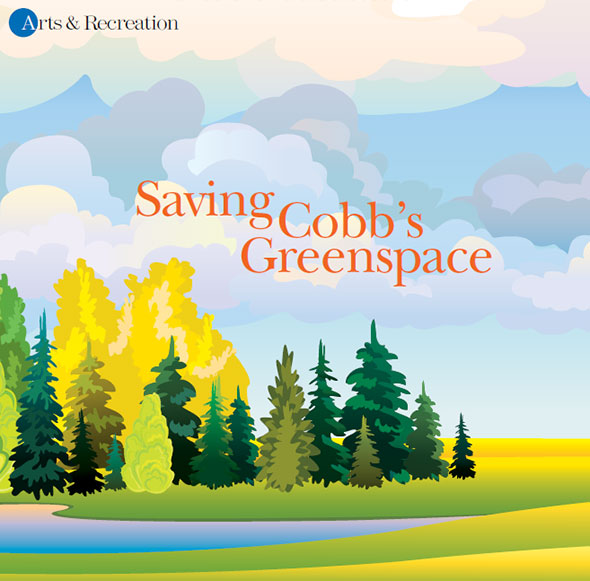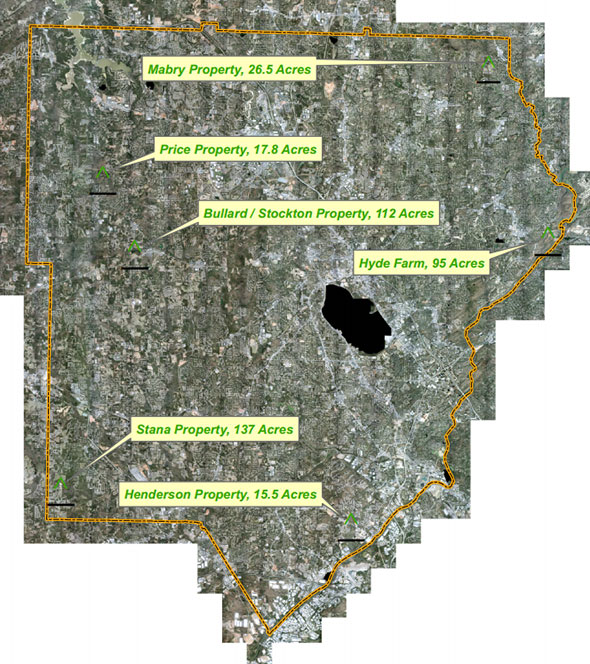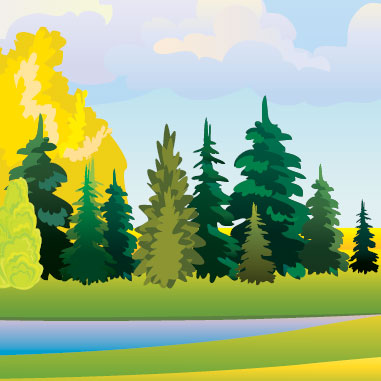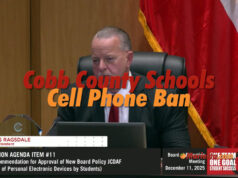
Preserving greenspace in Cobb County is a priority for many residents, be it for historical purposes, recreational interests or just a place for the kids to play. In 2006, Cobb voters approved issuing a $40 million bond to purchase much-needed parkland, and the county has since been working to enhance the quality of these park spaces for its residents. So far, this includes the acquisition of more than 300 acres of greenspace.
The bond, which was approved by an overwhelming majority, was much needed—of the 220,000 total acres of land in Cobb, more than 90 percent is developed. As available, undeveloped land has decreased, the prices for park-suitable space has increased. “We have been able to preserve some premium land around Cobb,” then Chairman Sam Olens says. “The parks bond helps us ensure future generations will be able to enjoy the natural beauty of our area. Each site has its own unique character and each will serve our residents for years to come.”
Creating Mabry Park
After voters approved the parks bond referendum, there was a nomination phase in which a citizen advisory committee evaluated citizen-nominated tracts to be presented to the Cobb County Board of Commissioners for final selection. “It should be noted that Mabry Park received more nominations than any other property,” says Lee Berg, president of Friends of Mabry Park. “Of course, Mabry Park made the cut and, during the next year, the 26.5 acres that is now Mabry Park was purchased by the county from Ed and Sue Mabry Harris for use as a passive park. However, by law, the parks bond money only provided for the purchase of the land, not the development of park amenities. The idea was to maximize the amount of acquired greenspace acreage.”
Berg became involved with Mabry Park in 2008 when then District 3 Cobb County Commissioner Tim Lee asked him to gather local neighborhood leaders to discuss the possibility of forming a “friends” group, modeled after the Friends of East Cobb Park. “Mark Jernigan, then president of The Enclave at Jefferson Ridge Homeowners’ Association, contacted me and asked if I would be willing to help him spearhead the formation of the Friends of Mabry Park,” explains Berg. “My wife, Mary, with her accounting background and experience in setting up corporations joined us and the Friends of Mabry Park was born.”
To Berg, preserving greenspace in Cobb is an invaluable task. “In the almost 25 years I have lived in Northeast Cobb County, I have seen many changes. As we all look into the future, it may be hard for most of us to imagine what this area will become,” says Berg. “One elderly resident with whom I occasionally converse recounts how her father was dismayed when they ‘brought power up Sandy Plains Road.’ My point is this: As this area changes, one thing will remain the same. The land that is currently Mabry Park will remain a park, a peaceful refuge from the busy world around it. Preserving greenspace in Cobb County isn’t just a benefit; it’s a necessary part of preserving society’s connection to nature, history and the community.”
Planning for Parks
Cobb County’s master plan calls for 10.5 acres of park space per 1,000 residents and the parks bond has helped move the county toward this goal. Cobb has 38 parks and six parks bond properties, including Mabry Park. Of the six parks bond properties, two are well over 100 acres. With a little more than $2 million left from the bond, the county is still looking to purchase more land, possibly including smaller tracts that could be used as pocket parks.
Karin Guzy, chairperson of the Cobb Land Trust (CLT), is highly in favor of pocket parks around Cobb. “The 122 acres at Heritage [Park] are wonderful and it’s a fabulous asset to the community, but it’s huge and requires a lot of maintenance,” says Guzy. “One thing we’ve learned at the Trust is that we’ve worked on different projects around the county and people care most about projects around where they live. Pocket parks service a smaller community and generally get more use. You don’t have to drive to get there, you can walk from your home, you can interact with your neighbors.” Pocket parks are also easier to fund and care for, and it is easier to find a greenspace that’s available and affordable. They can be anything from an acre up—in Seattle, for example, they’re not much bigger than a square block.
Guzy became involved with the CLT in 1992 because of the McFarlane Nature Park. “The property’s very near my home. I’m a gardener and they were looking for volunteers to help with the property and my husband said, ‘Well, that would be a good thing for you to work on,’” she recalls. “Both of us went over to the park and there was a community work day and we worked with our neighbors to clean up around the farmhouse and cut back shrubs, and it was such a wonderful property and so rare. It’s a puzzle piece that’s lifted out of residential properties.”
McFarlane was willed by Mr. and Mrs. William McFarlane to the community to be maintained as a passive park. The CLT had already been formed as a volunteer organization and its mission in Cobb County is to preserve greenspace for the enjoyment of the population, so it was a good match. The property’s 1940s slate-roofed farmhouse is a central feature to be developed. “The property’s been developed through the efforts of the community and lots of volunteers have worked on it more than 20 years,” says Guzy. “We’ve had more than 20 Eagle Scout projects completed at the park. The Cobb County Master Gardener Volunteers treat the property like a religion; they’re there every Tuesday morning working on pretty extensive display gardens of native piedmont plants. We only grow native plants outside of the immediate farmhouse yard, and the Master Gardeners have been magnificent.”
Expanding the Vision
The CLT has also done work with Heritage Park, and specifically the Silver Comet Trail, in order to protect the Nickajack watershed. They worked with the county to actualize the 12 miles that are within the county. The CLT has many plans for McFarlane in the future, including making it an arboretum, which won’t change its uses. “We want it to be an area where we can plant and appreciate and introduce people to native trees,” says Guzy. In March 2009, 33 new native trees were planted in McFarlane thanks to the county’s mitigation program, which ensures that all trees destroyed during development projects are replaced through a fund managed by Keep Cobb Beautiful. The trees planted include sycamores, brodie cedars, yellowwood, styrax, native crab apples, Carolina silver bells and halesias. “David Griffin, arborist with the county, came and assisted us, taught us how to plant the trees and worked with the Boy Scouts as well,” explains Guzy. “The Boy Scouts identified 100 trees at the park that were native and then we tagged all of those trees so visitors to the park can know what they are. In the next phase of that project we’d like to find a way to geo-locate those trees so when you’re walking around the park, on your smartphone you can read about the trees when you get there.”
The future and preservation of Cobb’s parks seems promising as both the government and community support their existence and continued use. To find out more about the county’s greenspace and how you can get involved with your local park, visit the Cobb County Parks, Recreation and Cultural Affairs Department at prca.cobbcountyga.gov or Keep Cobb Beautiful at facebook.com/keepcobbbeautiful for more information on programs and volunteer opportunities.
Parks Bond Properties
Henderson Property
Henderson is a potential trailhead opportunity and connection point with the proposed Nickajack Creek Greenway Walking Trail. The 16 acres of woodlands feature historic Civil War earthworks and complement the scope of the Greenway Trail plan.
Price Property
This 17.8-acre property adds to the county’s 100-plus acre Leone Hall Price property, much of which has been planned for passive park use. The additional parcel has a mix of hardwood and pine trees along with open field areas on high ground. Included in the master plan for this memorial park are an outdoor classroom, picnic and group shelters, a pavillion/stage, walking trails and a greenway connection to Lake Allatoona.
Green Meadows Preserve
The Bullard Stockton properties that make up the Green Meadows Preserve together total approximately 112 acres at Dallas Highway and Old Hamilton Road. They offer gently rolling hills and open fields reminiscent of Piedmont Park’s open meadow area, and provide unobstructed views of Kennesaw Mountain with a mix of open pasture and mature forest. Especially when combined with the contiguous existing Oregon Park, the size of this property would offer significant quality of life improvements for the public. The master plan for Green Meadows Preserve shows a main lot with parking for 200 parks, restrooms, a community garden, playgrounds and a picnic area.
Hyde Farm Property
Located on a ridge overlooking the Chattahoochee River, the property is in a key watershed protection area and contains branches of Mulberry Creek. The nearly pristine natural setting combines with an historic working farmstead dating back to the Civil War. Opportunities include passive recreation such as hiking, bird and wildlife observation as well as educational programming and field trips. Beloved by cyclists, the purchasing of this property was heralded by the community.
Cobb Landmarks holds a trust fund from The Trust for Public Land to assist in rehabilitating the farmhouse and outbuildings using national preservation standards. Because of its location, the farm offers the opportunity to tell the story of how families lived a self-sustainable lifestyle through farming, the hardships they endured, how national changes affected life locally in what-was-then rural Cobb County and the importance and value of water.
Mabry Property
This 26.5-acre parcel is one of the few large tracts remaining in East Cobb. Much of the land is open pasture with some wooded area surrounding a pond. The property has the feel of being in the country, even while in the middle of densely populated East Cobb. Currently the park is land-locked until an access road to the future park from Wesley Chapel Road is completed. The access road is the first and potentially biggest financial hurtle for Friends of Mabry Park, who are focused currently on raising funds to create Mabry Park.
The master plan for Mabry, which can be found at mabrypark.org, includes many amenities for the public such as a playground, walking trails, community garden, tree houses, lots of open meadows and a boardwalk across the wetlands area.
Stana Property, incorporated into Violet F. Stout Memorial Park
The 137-acre property is home to abundant wildlife and is a mix of open land and forest drained by medium-sized creeks. When combined with the contiguous existing Stout property, the resulting 200-plus acres will support multiple trail systems built for different types of users. This combined park is unusual in size and character for a largely urban region and would be bigger than Piedmont Park.

















